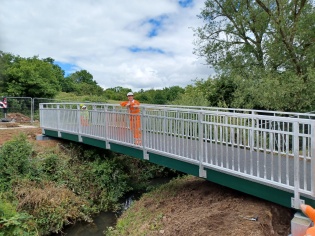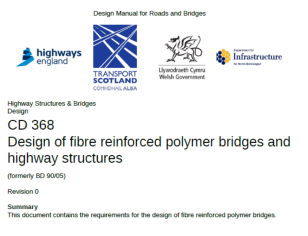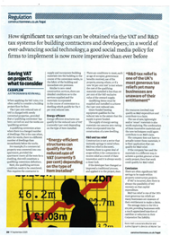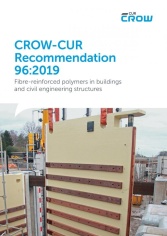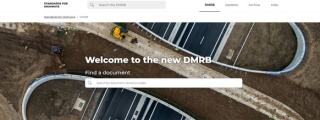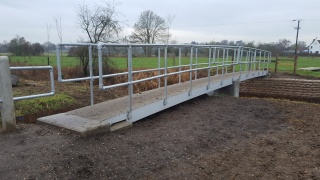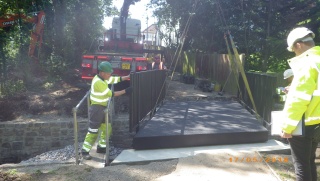Articles tagged “Pedestrian”
Collaborative Approach to Create New Bridge – Westons Farm Cycle Bridge
/ Martin Richardson / CD368, CD368, Composites UK, CUR96, Cycleway, Footbridge, Footbridge, FRP Composites, Pedestrian, Uncategorized
Working together with our sister company Concrete Repairs Limited, and our various other supply chain partners, a new 12.5m by 3.0m wide bridge has been installed. Initially Lifespan Structures were originally commissioned to produce an outline design to allow the Client to carry out the necessary consultation with the relevant statutory bodies, and subsequently develop this to a detailed design ready for the construction phase. The Client’s framework contractor employed Concrete Repairs Ltd to carry out the installation of the new bridge, including new foundations, lifting operations and attachment of parapet.
Lifespan Structures - Design Service
/ Martin Richardson / CD368, CD368, Composite, Composites UK, CUR96, CUR96, FRP Composites, Pedestrian, Timber Footbridge
Information on the design of FRP footbridges has developed quickly over the last few years, with the new version of the DMRB which included the publication of CD368 - Design of fibre reinforced polymer bridges and highway structures, and the updates to recommendations in Europe such as CROW-CUR recommendation 96-2019 Fibre-reinforced polymers in buildings and civil engineering structures (CUR96)
Whilst CD368 is now very much in line with CUR96, there are still some fundamental differences between the 2 documents.
Composite Bridges - A comparison between moulded and pultruded bridges.
/ Martin Richardson / CD368, Composite, Composite, CUR96, FRP Composites, FRP Composites, Lightweight, Pedestrian, Timber Footbridge
We have published a technical paper to help clients and specifiers understand the significant differences in terms of installation, performance and long term maintenance of the different types of FRP bridge solutions that are available. There are two generic types of FRP composite bridges and they have quite different performance characteristics and maintenance requirements, so it is important for clients to understand the differences at the procurement stage. Moulded bridge decks are generally manufactured in a mould with dry fibres laid in specific orientations with a core material to produce a sandwich construction.
New Botany Footbridge in Tonbridge
/ Martin Richardson / BD90/05, CD368, CD368, Composites UK, CUR96, Cycleway, Footbridge, Footbridge, FRP Composites, Pedestrian
Off site production allowed us to continue with this project during the lock down. Once restrictions were eased the existing bridge was removed and the foundations upgraded by CRL working for Kent Highways, before the new bridge was installed in June. KCC Cabinet Member for Highways and Transport, and Member for Tonbridge, Michael Payne said:
“This work was carried out to provide a strengthened and refurbished bridge to ensure it continues to be safe river crossing for the public to use. “The original deck was made from railway rails with a type of expanded metal mesh reinforcement, but unfortunately it wasn’t able to handle the number of people using it.
The use of an FRP Bridge could qualify for an R&D Tax Relief.
/ Martin Richardson / CD368, CD368, CUR96, CUR96, Cycleway, Footbridge, Footbridge, FRP Composites, Pedestrian
Very few people in the construction industry are aware of the significant commercial opportunity from identifying R&D processes and expenditure within the business. If a contractor has changed or improved a traditional process, and applied it to the project, then the resources involved may qualify as R&D expenditure and contribute to a claim. By offering an alternative construction technique using a Lifespan Structures composite deck, clients can often qualify for an R&D claim which will reduce the tendered costly of the scheme or enhance the profit margin.
CROW-CUR Recommendation 96:2019 - Now Available in English
/ Martin Richardson / BD90/05, CD368, CD368, CUR96, CUR96, Footbridge, Footbridge, FRP Composites, Pedestrian
The English Version of CUR96 is now available! CUR96 Recommendation describes the principles for the design of fibre-reinforced polymers (FRP)
It is available for download at https://crowplatform.com/product/crow-cur-recommendation-962019/
Please do contact us directly if you would like a to understand more about the content of this document.
The revised DMRB replaces BD90/05 with CD368
/ Martin Richardson / BD90/05, BD90/05, CD368, CD368, CUR96, CUR96, Cycleway, Footbridge, FRP Composites, Pedestrian
The DMRB was updated by Highways England just before the lockdown started. We were probably all distracted from noticing this at the time. The technical changes were substantial, especially regarding FRP bridges but the structure of the suite of documents changed. A summary of these changes can be seen at (https://standardsforhighways.co.uk/dmrb/help#new-structure)
One key change for us is the replacement of BD90/05 with CD368. CD368 updates the approach to FRP bridges. The new approach is now quite closely aligned with current European guidance documents.
FRP Composites provide a sustainable solution
/ Martin Richardson / BD90/05, BD90/05, Composite, Composite, CUR96, Footbridge, Footbridge, FRP Composites, FRP Composites, Pedestrian, Pedestrian
The construction industry is committed to reducing the environmental impact of its activities. The Construction 2025 joint strategy from the UK Government and industry, working in partnership, sets a vision, which includes 50% lower emissions, 33% lower costs and 50% faster delivery. Using FRP composites in place of steel and concrete for bridge construction will deliver this vision now. The carbon and energy embodiment is significantly reduced at the construction stage and still further during the 100-year minimum service life.
PROW Benefits from new 2 span FRP Footbridge
/ Martin Richardson / Bridleway, CUR96, Footbridge, Footpath, FRP Composites, FRP Composites, Lightweight, Pedestrian, Pedestrian, PROW, PROW, Timber Footbridge
This Public Rights of Way (PROW), 2 span bridge was installed in December 2018. The lightweight nature allowed easy installation in this remote location during the winter months and moulded deck technology means long term maintenance will be reduced to a minimum. The total length of the bridge was 14m and 0.905m wide between the handrails. The handrails were attached to the outside edge of the bridge to minimise the overall width of the structure to suit site constraints. The project demonstrates that FRP bridges can be a cost effective, durable alternative to traditional construction methods for small remote structures.
Hounsden Gutter Project Completed
/ Martin Richardson / BD90/05, BD90/05, Carbon Fibre, Composite, Composite, CUR96, CUR96, Cycleway, Footbridge, Footbridge, FRP Composites, FRP Composites, Pedestrian, Timber Footbridge, Uncategorized
The existing skewed reinforced concrete footbridge had come to the end of it life, so an FRP Replacement was selected to provide reduced maintenance in the tree enclosed environment over the Gutter. Following completion of new abutments and associated retaining walls, the lightweight, preformed, replacement allowed fast and simple installation on site using a lorry mounted crane, to both transport and lift the bridge into place. The colour scheme was selected to match the clients requirements.

